On November 21, 1980, a devastating fire broke out at the MGM Grand Hotel and Casino in Las Vegas, leaving a lasting impact on the history of fire safety. This tragic event resulted in the deaths of 85 people, making it one of the deadliest hotel fires in U.S. history.
The Cause of the Fire
The fire at the MGM Grand Hotel and Casino was ignited by an electrical fault. It started in a restaurant located on the casino floor and quickly spread throughout the building. The hotel’s lack of fire sprinklers and other safety measures contributed to the rapid escalation of the fire.
As the flames engulfed the casino and hotel, guests and employees faced tremendous challenges in escaping the burning building. The thick smoke and intense heat made it difficult for people to find their way to safety, resulting in the tragic loss of lives.
The Impact on Fire Safety Standards
The MGM Grand Hotel and Casino fire served as a wake-up call for the hospitality industry and the public at large. The disaster highlighted the need for improved fire safety measures in hotels and public buildings.
Following the fire, significant changes were made to safety standards and building codes. One of the most important developments was the widespread adoption of automatic fire sprinkler systems. These systems are designed to detect and extinguish fires automatically, providing early intervention and containment until firefighters arrive.
Additionally, the MGM Grand Hotel and Casino fire led to improvements in evacuation procedures. It emphasized the importance of clear exit signage, well-maintained emergency exits, and regular fire drills to ensure that occupants are prepared to respond quickly and efficiently in the event of a fire.
Fire safety experts and organizations also worked to educate the public about fire prevention and safety measures. This included raising awareness about the importance of smoke detectors, fire extinguishers, and the proper use of these devices.
The Lasting Legacy
The tragedy at the MGM Grand Hotel and Casino had a profound and lasting impact on fire safety regulations and practices. It served as a catalyst for change, prompting authorities to reevaluate and strengthen existing safety standards.
Today, fire sprinkler systems are mandatory in most hotels and public buildings, significantly reducing the risk of fire-related casualties. Building codes now emphasize the importance of multiple means of egress, fire-resistant materials, and regular inspections to ensure compliance with safety regulations.
The MGM Grand Hotel and Casino fire also led to advancements in fire investigation techniques. Investigators studied the incident to better understand fire behavior and develop strategies to prevent similar tragedies in the future.
As time passed, the lessons learned from this tragic event have continued to shape fire safety practices around the world. The MGM Grand Hotel and Casino fire serves as a stark reminder of the importance of proactive measures to prevent fires and protect lives.
Conclusion
The 1980 fire at the MGM Grand Hotel and Casino in Las Vegas was a tragic event that claimed the lives of 85 people. However, it also served as a catalyst for change, leading to significant improvements in fire safety standards and regulations.
The lessons learned from this devastating incident have helped shape the way we approach fire safety in hotels and public buildings. The implementation of automatic fire sprinkler systems, improved evacuation procedures, and increased awareness of fire prevention measures have undoubtedly saved countless lives.
While the MGM Grand Hotel and Casino fire will forever be remembered as a tragedy, its impact on fire safety has been instrumental in preventing similar incidents in the future. The legacy of this event serves as a constant reminder of the importance of prioritizing fire safety in all aspects of our lives.
SEO excerpt: The 1980 MGM Grand Hotel and Casino fire in Las Vegas was a tragic event that claimed the lives of 85 people. This devastating incident led to significant improvements in fire safety standards, including the widespread adoption of automatic fire sprinkler systems and enhanced evacuation procedures. Learn more about the lasting impact of this tragedy and its role in shaping fire safety regulations.

